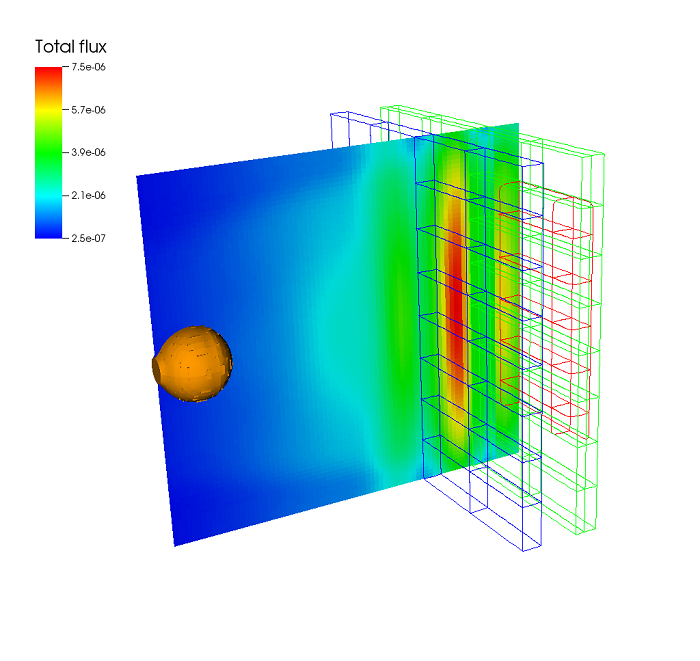Robert Anderson (17-ERD-026)
Executive Summary
Our reduced-order modeling project aims to develop a methodology that minimizes the computation resources and increases the execution speed of high-performance computing simulations of national importance by focusing on the most important degrees of freedom in these models. Our choice of radiation transport and hydrodynamics as physical models for reduced-modeling research are relevant to both high-energy-density science and stockpile stewardship science.
Project Description
Rapid advances in both computing capabilities and efficient algorithms make it possible to carry out simulations of physics-based models of increasing size and complexity. In some situations, however, the primary requirement is not maximizing the fidelity of the model, but in quickly providing sufficiently accurate solutions, such as in design optimization, real-time control, and on-demand disaster modeling. In these cases, we prefer an alternate model formulation that trades generality for a large reduction in model size and computing costs. This process is known as model reduction and combines methods from physics-based simulation, data science, and data compression. Our project focuses on advancing reduced-order modeling as applied to a suite of Laboratory-relevant models based on partial differential equations (PDEs). Reduced-order modeling transforms general, high-dimensional, high-fidelity models into more specialized, but still accurate, lower-dimensional models that execute quickly. Fast execution is essential when many model queries are needed or real-time constraints exist such as in emergency response situations. We are developing efficient and scalable hyper-reduction methods for nonlinear systems, error analysis and control methods, and adaptive methods for shock modeling.
We expect to advance the state-of-the-art in reduced-order modeling by focusing research and development on (1) efficient and scalable hyper-reduction methods for nonlinear systems; (2) error analysis and control, and (3) adaptive methods for shock modeling. Our research efforts are coordinated in support of concrete reduced-order model capabilities, building on existing Lawrence Livermore high-fidelity models and codes. If successful, we expect these models will find increased utility in optimization, inverse problems, and other many-query settings, and the models proposed will be novel contributions to the broader field of large-scale reduced-order modeling. We are exploring novel error estimates and algorithms in nonlinear and adaptive reduced-order models, with the intention of demonstrating these algorithms on linear transport, nonlinear radiation, and hydrodynamics models. We are developing hyper-reduction methods that have low memory and low computational intensity requirements suitable for a high-performance computing setting. Novel error estimates involving derivatives and parameter sensitivities is another expected result. We are also developing basis enrichment, or adaptivity, which is suitable for use in a nonlinear setting.
Mission Relevance
Reduced-order modeling supports DOE's science and energy objective to deliver scientific tools that transform our understanding of nature and strengthen connections between fundamental scientific advances and technological innovations, and also applies to the Laboratory's high-performance computing, simulation, and data science core competency by advancing high-performance computing to understand and predict the behavior of complex systems.
FY17 Accomplishments and Results
In FY17 we (1) constructed and exercised a reduced-order model of ARDRA, a Boltzmann Transport code, and exercised it on a range of problems, demonstrating reductions from 700 million degrees of freedom to less than 100, with errors on the order of 1% on problems with three-dimensional geometry; and (2) made progress developing a theory of error estimates in linear systems, in particular showing how the use of derivative snapshots can improve the accuracy of the method.
Publications and Presentations
Kostova-Vassilevskaa, T., G. M. Oxberry. 2017. "Model Reduction of Dynamical Systems by Proper Orthogonal Decomposition: Error Bounds and Comparison of Methods Using Snapshots from the Solution and the Time Derivatives - ScienceDirect." Journal of Computational and Applied Mathematics, 330:553-573. doi: 10.1016/j.cam.2017.09.001. LLNL-JRNL-720257.
Oxberry, G. M., et al. 2017. "libROM: A Distributed-Memory Adaptive Incremental Proper Orthogonal Decomposition." LLNL-PRES-725445.






